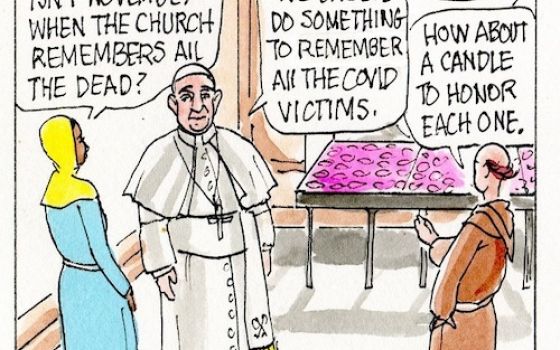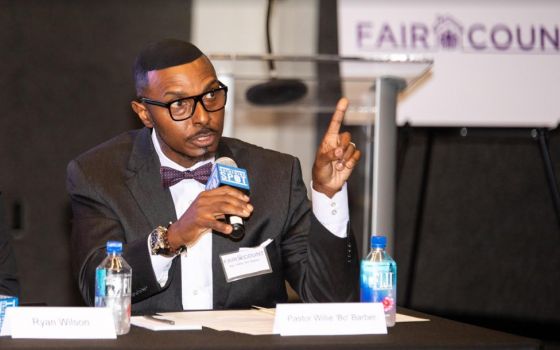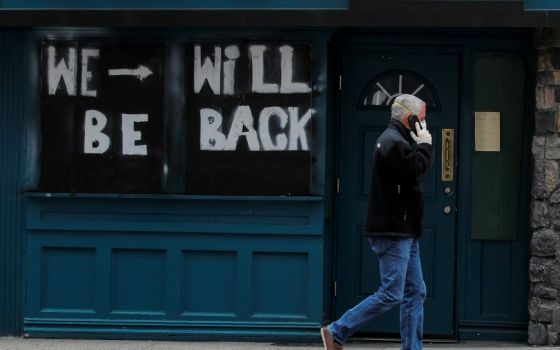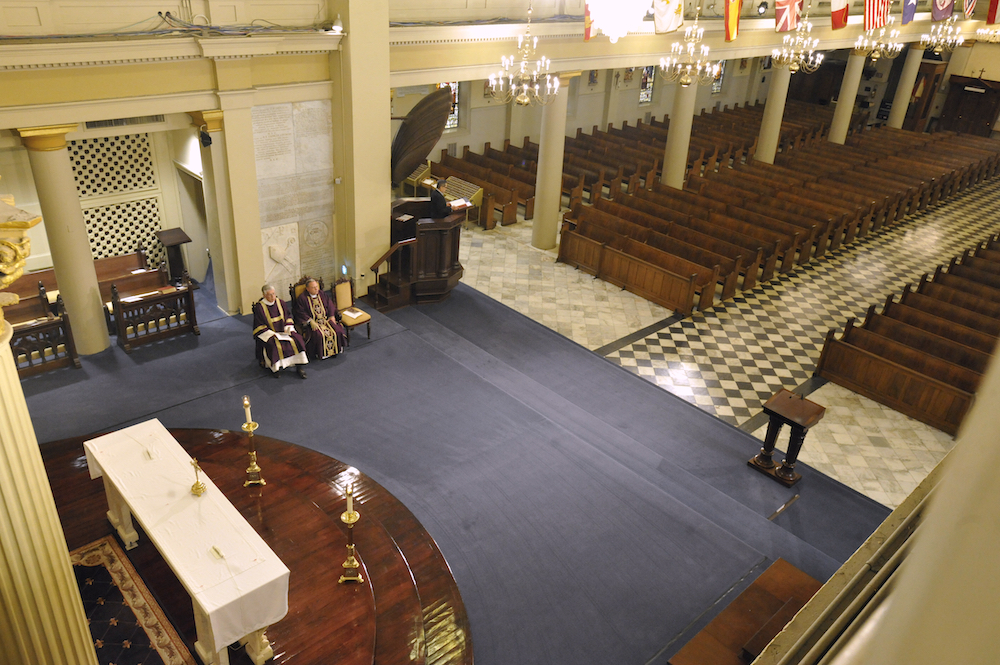
Lector Philip Alviar reads from the Book of Deuteronomy during a private Mass March 17, 2020, inside the empty, 950-seat St. Louis Cathedral in New Orleans. New Orleans Archbishop Gregory Aymond canceled all public Masses in the archdiocese to slow the spread of coronavirus. The Mass was aired live on local television and livestreamed at TheDailyMass.com. (CNS/Clarion Herald/Peter Finney Jr.)
In March, the azaleas blossom like tiny valentines on the grassy St. Charles Avenue median where streetcars trundle past the Garden District, heading toward Uptown. It is barely three weeks since the last Mardi Gras parade. Doused in milky sunlight, the plastic beads tossed by maskers on the decorated floats hang in oak limbs that snagged them from waiting hands. And now, the coronavirus pandemic curls its tentacles around a city of festive folkways, squeezing us into an eerie new abnormal.
On March 10, Louisiana had its first reported coronavirus case. Eight days later, 240 people have tested positive, out of 575 tested in less than a third of the civil parishes, or counties, with six deaths attributed to COVID-19, the disease caused by the virus, according to state officials. The deaths and 176 cases have been reported in New Orleans, the epicenter of a state that "now has the third-highest rate per capita in the country," reports the Times-Picayune/Advocate.
The three-week Carnival season of crowds at parades, dancing at balls and packed music clubs seems now a perfect storm for "community spread."
Advertisement
On Monday, March 16*, Mayor LaToya Cantrell ordered the closure of bars, music clubs, casinos, and gyms and restricted restaurants to deliveries only. Gov. John Bel Edwards issued a similar order statewide for at least 30 days. Archbishop Gregory Aymond announced the cancellation of church Masses indefinitely to support social distancing. The hope behind these measures is to "flatten the curve," reducing the acceleration rate of the virus, which has devastated Italy and tilted the world economy.
Tourism is the top industry here. In 2018, the city enjoyed a $9.1 billion impact from 18.5 million visitors, according to a consultant study by D.K. Shifflet & Associates. As news of the virus surged, large conventions began cancelling. So did two major conferences scheduled for late March: Tulane's New Orleans Book Festival, with John Grisham and Malcolm Gladwell among its speakers, and the Tennessee Williams Literary Festival, in its 34th year, the headliners including St. Joseph Sr. Helen Prejean and novelist Colm Tóibín.
April's French Quarter Festival featuring several music stages cancelled, costing hundreds of musicians and sound engineers their expected paychecks, along with anticipated revenues from restaurants and bars in the economy's peak season. French Quarter Fest announced its hope of rescheduling in October, barring a worse free-fall in tourist travel.
The 50-year old New Orleans Jazz and Heritage Festival draws hundreds of thousands of music aficionados for a 10-day stretch between the last weekend of April and first weekend of May. Jazz Fest is a $300 million annual pump for the economy. On March 17, the festival announced it would postpone the event, hoping to reschedule in the fall.
Mayor Cantrell, who ran as a populist, cancelled the St. Patrick's and Mardi Gras Indians Super Sunday parades on March 14. The mayor recoiled from media coverage of people drinking and partying in the warm sunlight on Magazine Street in the Irish Channel neighborhood, outside Tracey's Bar — a violation of the city's order, at the time, of no crowd exceeding 250 people. New Orleans police scattered the crowd.
The next day, Cantrell urged people to be "vigilant" in social distancing. "Use your head, stop the spread."
"A lot of people haven't come to terms with this pandemic, certainly our president hasn't, " Vincentian Fr. Louis Arceneaux, who has ministered in the city for decades, told NCR. "People outside Tracey's don't get it — fact that you may not be sick, but go home and hug your grandmother, and she can get sick! I don't see people catching on how communicable this stuff is."
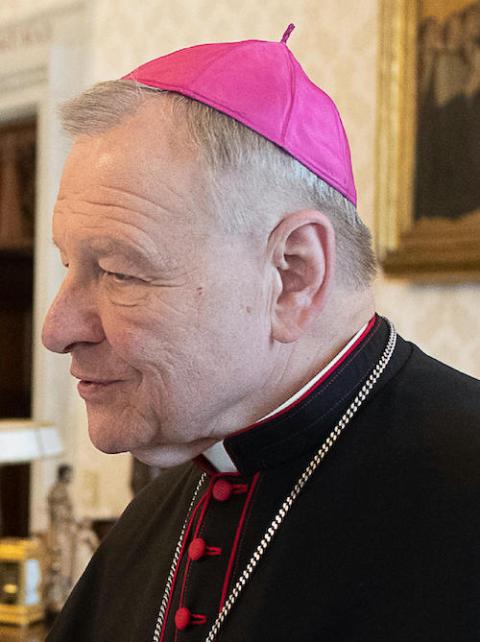
New Orleans Archbishop Gregory Aymond, shown here during his ad limina visit to the Vatican in December 2019, has announced the cancellation of church Masses indefinitely to support social distancing. (CNS/Vatican Media)
"I did the 10 a.m. Mass on Sunday at St. Joseph's [in the mid-city medical district]. I brought up coronavirus in the sermon. After Mass, people thanked me, and wanted to hug. I'm a hugger, but I'm not hugging. I tell people, 'I love you but I really don't want you to touch me.' "
Tracking social spread
As church bells tolled on St. Patrick's Day, the hardest-hit facility in New Orleans was Lambeth House, a multi-story retirement complex with a nursing wing. The large brick structure at a corner of affluent Uptown has sweeping views of the Mississippi River from balconies and terraces. With three deaths from COVID-19 confirmed, Lambeth House is under quarantine, with a cluster of 12 residents or patients testing positive as of March 18.
Lambeth House residents pay a $275,000 registration fee with 90% refundable to designated heirs upon the person's demise, unless he or she withdraws first. Monthly fees start at $2,971, depending on apartment size, according to its website.
Many Lambeth residents come from prominent families and have active social lives, particularly at the winter Carnival balls; some travel abroad. As the Centers for Disease Control and Prevention sent specialists to conduct testing, one relative of a Lambeth resident, who spoke on background, suggested the cases may be tied to the funeral of a society matriarch, just after Mardi Gras, which drew many mourners, including Lambeth residents, among people who had gone to the parades, and others returning from European travel.
Social distancing strikes a weird tone in the rhythms of a city that thrives on crowds at parades, outdoor markets, music clubs and dozens of festivals where bands play and people feast on boiled crawfish, jambalaya (seasoned rice with shrimp and sausage), gumbo and fried oysters. High cholesterol is not a major issue in these latitudes.
But a survival ethos marks New Orleans to its marrow. The overarching lesson of the epic Hurricane Katrina flooding in 2005 is one of human grit. Most of the city's 484,000 residents fled by car, as 80% of the urban area filled with water; the city barred people from returning for a month. Musicians were among the first wave getting back, to kickstart the night clubs and perform at funerals despite many of the players having lost their homes. Countless people exhausted their savings while fighting with insurance adjustors, digging muck out of flooded homes, stripping walls, and making repairs that ran for months and sometimes years. A $9 billion federal relief program, Road Home, plagued by bureaucratic inertia, nevertheless paid an average grant of $69,000 to cover the difference that insurance companies did not pay. Today, the population stands at 393,000.
The character of this offbeat town — where the 1960's mayor, Victor Hugo Schiro, famously declared, "Don't believe any rumors unless they come from my office" — is rife with cynicism toward politicians and the police department. Yet as the pandemic grew like some sci-fi plague, the logic of the emergency measures began settling like a dark cloud.
Cost to jobs in the arts and hospitality industries
"Before these orders kicked in, I lost a $2,500 job for three days of film work, postponed till May," says George Ingmire, a sound engineer for film and music productions. "I don't know what to expect. There won't be much work unless I'm in my home studio doing audio or video editing."
Like thousands of people in the so-called gig economy, Ingmire does part-time work as a tour guide and operates a pedicab to supplement his other contracts. "At 51, I'm 20 years older than other people pedicabbing. I need work that allows flexibility. I told the company on Sunday I felt like a sitting duck, touching money and surfaces, with people coughing; now with all these shut-downs, the foot traffic is gone. The whole country is evacuating, but not evacuating, so to speak."
Ingmire's plunge is typical of some 7,400 workers in Louisiana's burgeoning film industry, as estimated by the state. Many, unlike Ingmire, are union members. The state provides tax credits to film companies, allowing them to recoup some of their expenses, feeding an annual economy of roughly $500 million with dozens of productions at a given time.
"Right now, we're aware of only two production crews at work, with 30 people each," says Cory Parker, business agent of the 1,500-member Local 478 of the International Alliance of Theatrical Stage Employees, Moving Pictures Technicians, Artists and Allied Crafts.
Parker estimates "about 5,000 people in film and television production now out of work. That figure does not include stage-hands who do convention work," theatrical stage employees, ushers, ticket-takers and concession workers, whose ranks constitute some 10,000 entertainment laborers, mostly in New Orleans.
IATSE Local 478 is guiding its members to apply for unemployment. "Most of them have never done that," says Parker. "We're talking with the state, trying to streamline the process. IATSE has a national benefit fund, and they're working on a plan to help people keep their health coverage."
Nationally, IATSE officials are lobbying Congress to include entertainment workers in House Resolution 6201 (Families First Coronavirus Response Act), which has gone to the Senate but not been taken up there for consideration yet — and will require an amendment in the final bill for a major relief package.
As the massive shutdown rolls out, Fr. Peter Finney III, pastor of St. Rita Catholic Church, planned to livestream Mass on Facebook. He worried about working mothers of the children who attend the parish school. "A private school or more affluent Catholic school can come up with a distance learning alternative. This parish is a small operation. Our scholars don't have Wi-Fi — they go to the library for that," he told NCR. "To say 'set up parallel learning' is hard for a clientele like ours. … Many people are wondering how they will last a month."
As the pandemic escalates, economists and civic leaders interviewed in local media have found a mantra, estimating a 30-day period of social distancing before the economy tanks. What if it takes 60 or 90 days? An acute concern voiced by health officials and medical workers on the front line is whether hospitals and clinics have enough capacity for the number of sick people, destined to rise, especially in areas with poor people, who account for nearly a third of the population here.
*Editor's note: A typographical error has been corrected to indicate the correct month.
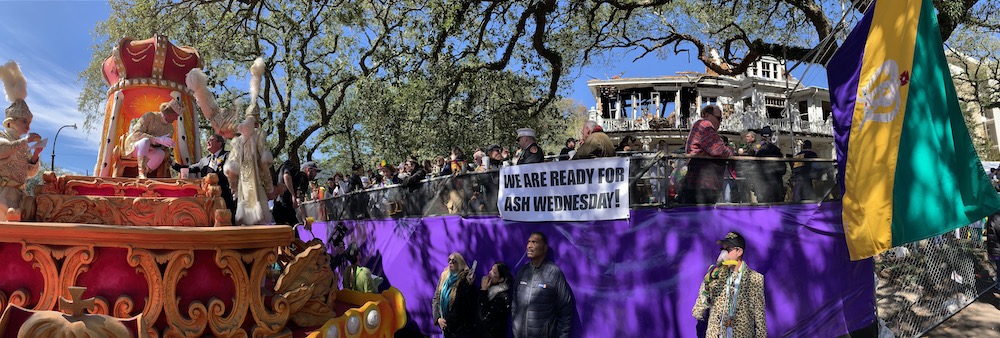
People in New Orleans celebrate Mardi Gras March 5, 2019. (CNS/Clarion Herald/Peter Finney Jr.)
[Jason Berry is finishing a film documentary based on his recent book, City of a Million Dreams, in which burial traditions form a prism on New Orleans history.]




